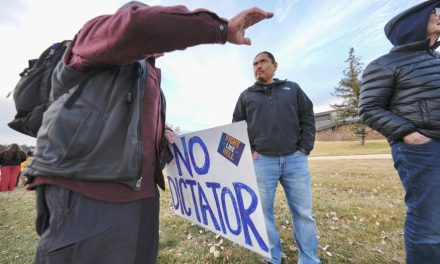
‘Patchwork of accountability’: Cove Day School closed due to radioactive hot spots
WINDOW ROCK
The fallout from the Red Valley uranium mining era lingers as now, over 60 years later, the safety of the Cove Day School, which serves children in K to 3rd grades, is being questioned.
The Department to Diné Education was recently informed that there are four unresolved radiation “hot spots” located on the school’s exterior grounds as well as four areas of elevated radon, a carcinogenic radioactive gas, located inside the school.
Upon review, Bureau of Indian Education officials took immediately closed the school before it opened for the fall semester. Its 44 students are receiving educational instruction remotely.
The Cove principal, teachers and other personnel are temporarily continuing their work through the Red Rock Day School.
“There are no students occupying the campus and the teachers have been teleworking and engaged in virtual teaching,” said Walter Coulter, BIE program administrator for Navajo schools in Arizona.
The recent hot-spot information rose to the surface early this summer because the BIA’s Division of Facilities Management and Construction had begun planning and design for the construction of the “new” Cove Day School, funded by the federal government in 2016, that included environmental studies and gamma radiation surveys.
In July, the Navajo Environmental Protection Agency was notified that the project included plans for hazardous substance remediation in areas of elevated radioactive contamination on school grounds.
Delegate Amber Crotty, who represents Cove, said, “We’re grateful that Cove Day School finally has the funding for a new school, but I think the question that parents and community members are asking me is why this wasn’t found in prior surveys or remediation efforts’
“And when was the last time the school was checked for any type of high level or concentration of tailings to make sure that the children and the staff and community members are safe?” she asked.
According to a recent Navajo Superfund report, 50 of the Navajo Nation’s 523 abandoned uranium mines are in the Cove Wash watershed.
Two transfer stations are located in Cove where, back in the active mining days, uranium ore was temporarily stored. Transfer Station No. 1 is located about 300 feet northeast of the school.
In the 2000’s, Navajo Abandoned Mine Lands performed reclamation activities at TS1 and TS2, but due to increased levels of radioactive contamination still found at the sites, in 2012 U.S. EPA conducted a removal action of contaminated soil there.
However, it remains unclear as to what extent adjacent Cove Day School was impacted by the transfer station contamination.
Communication gaps, health impacts
In presentations to the Health, Education and Human Services Committee in the past two weeks by the various agencies responsible for school safety and remediation of radioactive mine sites on Navajo, it quickly became evident that with the changing of the guard over decades at the BIA, BIE, NNEPA and the U.S. EPA, much has fallen through the proverbial cracks, including inter-agency communication and consultation with the Navajo government.
While those currently in charge at the agencies are not responsible for “balls dropped” in the past, there is still no centralized information repository that would include all historical radiation and remediation reports that have been collected over time.
“We took a look at the reports we could find,” said Pearl Chamberlin, BIA Region Division of Engineering director. “It looks like EPA had done an assessment back in 2012… we don’t have the whole picture yet…”
In the meantime, she said, there have been meetings with BIA, BIE, NNEPA and U.S. EPA to coordinate the presentation on Cove school radioactivity.
“I’m sure there’s documents that go all the way back to 1992, but folks on this call don’t know about that information,” said committee Chairman Daniel Tso. “When that information was gathered, there was a duty of trust responsibility to let the (Navajo Nation) government body know.”
Tso said the committee and the president’s office only became aware of the Cove school situation because DODE Superintendent Patricia Gonnie informed them after receiving an email from a 93-638 contractor.
“Without that, we would have never known,” said Tso.
One of the five hotspots discovered located on the playground has already been remediated and the remaining four are in the “draft work plan” stage being reviewed by BIA, NNEPA and U.S. EPA, according to George Padilla, Navajo Region BIA environmental scientist.
“A field sampling plan has been completed and the next step is to remove those four soil contaminated locations at the school,” said Padilla.
As far as the interior radon hotspots, those were discovered in 2016 after the Navajo EPA completed a radon survey inside of the school, but evidently nothing was done since to address them even though the BIA was notified.
Tso expressed concern over how long students, staff and community members may have been exposed to both radiation from contaminated hot spots and radioactive radon gas in the air.
“I guess the biggest question now is the health status of those young folks who went through that school and the staff,” said Tso. “We haven’t even started talking about the implications…”
Navajo EPA Director Valinda Shirley, who has been on the job since February, said the agency knew about the two Cove transfer stations, which were reclamation sites since the early 1990s.
“Since the identification of the transfer stations, there were different reports and different scanning that were done,” said Shirley. “As far as the school, U.S. EPA and Navajo EPA, we thought scanning was done around schools, but we don’t have those reports.”
‘Almost unconscionable’
Committee Vice Chair Carl Slater said it seemed like there was “a real lack of initiative” on the part of EPA, BIE, and BIA considering Cove is a known mining area on the Navajo Nation.
“The way this presentation was delivered is really uninspiring,” he said. “To say, ‘I don’t know when this report was there or this or that’… With high level BIA folks on the line, this committee expects quality.”
Slater said those making reports should have “facts readily available” and the various agencies involved should coordinate to “make sure there’s a consistent message.”
He indicated that rather than allaying the committee’s fears about the welfare and safety of the school children, the piecemeal, incomplete reports just left them with more questions.
“We have to look at the health impacts, including how exposure to environmental contaminants impede neurological development and results in immune system suppression,” said Tso. “It may increase the risk of cancer and other illnesses as well as quality of life losses.”
Tso said it’s “almost unconscionable” that the red flag regarding the risks at Cove had not been raised earlier.
“That is something that we’ll be working on with the U.S. EPA agency as they’ve been in the area addressing these mine areas for the last 20 years and see what the protocol is on testing individuals for health concerns,” said Chamberlain. “We’ll certainly take a look at the remediation activities that were held because they would have notified government agencies if there was huge risk.”
“We’ll have to take a look at the files, historical information, what was done and review those correspondence,” she said.
‘What’s missing’
Navajo Superfund Environmental Program Supervisor Darriel Yazzie confirmed that the Cove transfer stations are included in the listing of abandoned uranium mines on the Navajo Nation.
“Transfer Station 2, that’s located across the road from the Cove Day School, had been scanned, characterized and fully identified back in the 90s,” said Yazzie.
“Navajo AML under the guidance of the Surface Mining Control and Reclamation Act, did some initial work to address physical hazards that existed at these sites so some preliminary site investigations had been done,” he said.
He said in its role, Superfund identifies the responsible parties for all of the hazards and potential hazards.
“We’ve been involved in identifying what’s been missing here,” said Yazzie.
However, Yazzie said his office was not included in discussion about the Cove Day School early on.
“We got wind of this about a month ago and our ED did request a cease-and-desist order before anything happens,” he said. “When you start handling hazardous waste, you need to identify where everything is going and where it’s being hauled to.”
“There’s a patchwork right now of accountability,” said Slater. “Institutions didn’t follow up in the past. We need to think through how we can prevent this in the future.”
“I would strongly recommend, Ms. Shirley, that you grab the bull by the horns,” he said. “It seems like there’s a lot of cracks in the system where something like this can take place.”
Tso said it was also evident that proper federal-tribal communication didn’t occur and the trust responsibility has not been honored.
“The future health of these young folks and those who attended since the early nineties – now we’ve affected their health,” said Tso. “We, meaning the United States government and an agency of the U.S. government.”
Bart Stevens, BIA’s deputy director for field operations, acknowledged that communications and consultation needed to be improved and said that the Cove Day School issue has garnered the attention of the “Central Office” and Bryan Newland, assistant secretary for Indian affairs at the Department of the Interior.
“As far as Indian affairs, which includes BIE and BIA, we certainly share the concerns that everyone is bringing forward,” he said. “I want to recommit Indian affairs to resolving the issues and doing what’s best for the safety of the staff, students and community members.”
Next steps, radiological scans
Sharon Pinto, deputy director for BIE school operations, said when BIE became aware of concerns over radioactivity at Cove Day School, they thought it was most appropriate to ensure technical folks were brought in to assess the safety.
She said the BIE relies on the BIA regional environmental team to assist with environment support and remediation services and U.S. EPA and NNEPA for reports.
“I think everyone’s been trying to be helpful and responsive, but we need one source of direction,” said Pinto. “As far as BIE, we’re here to deliver education to the students in the best, safe manner.”
In response to the Cove school revelations, the U.S. EPA committed to doing a radiological scan of the interior school buildings starting the week of Sept. 6, and the NNEPA Radon Program conducted another interior radon gas assessment last weekend, with results pending.
Eugenia Quintana, manager of the Air and Toxics Department at NNEPA, explained that radioactive radon, which comes from the natural breakdown of uranium, is an invisible gas that can only be detected through testing.
She said long-term exposure to radon causes thousands of deaths each year and is the second leading cause of lung cancer.
“We encourage all schools across the Navajo Nation to continue to test for radon to make sure their occupants, particularly the young children, have access to their education in an environment that has the least exposure to environmental hazards,” she said.
Even though there is “no safe level of radon,” the radioactive gas is not regulated by U.S. EPA because it is “everywhere,” said Quintana, but there are “actions levels” associated with high levels of radon, measured at 4 picocuries per liter or above, at which the USEPA recommends corrective measures to reduce exposure.
She indicated that radon can be mitigated effectively and inexpensively, including through improved ventilation.
When Cove Day School was tested in 2016, she said, various levels of radon were found throughout the school, but four areas were in a “high-action” level range, between 4 and 5.8 pCi/L, she said.
Subsequently, on July 20, 2016, NNEPA in coordination with U.S. EPA, sent a letter to the Navajo Regional BIA office recommending installation of radon mitigation systems as part of construction of new Cove Day School, which had already been funded back then.
Quintana said her office never heard a response.
Jesse Kass, U.S. EPA remedial project manager, said his team was mobilizing an experienced radiological assessment firm that will collect gamma radiation data inside the main school building and three modular buildings.
Together with NNEPA, they will look at results and make assessments of conditions inside of school and advise stakeholders how to move forward.
Meanwhile, Kass said he believes its “appropriate” that the BIA is moving quickly to clean up the exterior hot spots ahead of construction of a new school, which could pose long-term cancer risk for those who spent a “significant amount of time” near them.
Pinto said the Cove school will remain closed pending completion and results of the surveys and assessments being done by technical advisors.








 Highway 264,
Highway 264, I-40, WB @ Winslow
I-40, WB @ Winslow